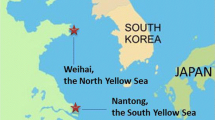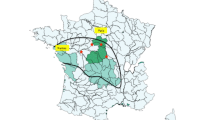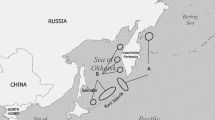Abstract
The concentrations of a number of polychlorinated biphenyls and chlorinated pesticides in brain tissues of marine mammals of different age and regional origin were determined by using high-resolution capillary gas chromatography and electron capture detection. Brain tissues of two neonatal and three stillborn northern fur seals (Callorhinus ursinus) collected in the Bering Sea, Pacific Ocean, were examined. In addition, cerebrum, cerebellum, and hypothalamus of one adult female common dolphin (Delphinus delphis) stranded on the coast of Massachusetts, Atlantic Ocean, were examined. It showed clearly that α-HCH was dominant in all brain tissues (90–203 ng/g extractable lipids) compared with other tissues like liver or blubber (45–61 ng/g extractable lipids). This excess of α-HCH in brain tissue was due to only one enantiomer, (+)-α-HCH, whereas in other tissues both enantiomers contributed to the α-HCH concentration. Comparing the overall general xenobiotic burden, the HCH isomers (99–216 ng/g extractable lipids) resemble the PCB (17–105 ng/g extractable lipids) and DDT (111–171 ng/g extractable lipids) levels in brain tissues. The latter two groups exceed the HCHs in liver tissue and in blubber. On a single compound basis, the highest levels are found in brain for α-HCH (fur seal pups: 90–203 ng/g extractable lipids, adult dolphin: 221–305 ng/g extractable lipids), 2,2′,4,4′,5,5′-hexachlorobiphenyl (PCB153) (fur seal pups: 4–25 ng/g extractable lipids, adult dolphin: 260–377 ng/g extractable lipids) and 4,4′-DDE (fur seal pups: 104–164 ng/g extractable lipids, adult dolphin: 364–625 ng/g extractable lipids). The levels of α-HCH and 4,4′-DDE are comparable. No significant difference concerning the xenobiotic burden between neonatal and stillborn northern fur seals could be seen in contrast to the higher concentrations of the adult common dolphin. The patterns of some xenobiotics in the samples were compared with each other by using statistical methods like the similarity index and the principal component analysis (PCA).
Similar content being viewed by others
References
Abarnou A, Robineau D, Michel P (1986) Oceanologica Acta 9:19–29
Tanabe S, Tanaka H, Tatsukawa R (1984) Arch Environ Contam Toxicol 13:731–738
Andersson Ö, Linder C-E, Olsson M, Reutergårdh L, Uvemo U-B, Wideqvist U (1988) Arch Environ Contam Toxicol 17:755–765
Tanabe S, Tatsukawa R, Maruyama K, Miyazaki N (1982) Agric Biol Chem 46:1249–1254
Addison RF, Brodie PF (1977) J Fish Res Board Can 34:937–941
Ballschmiter K, Zell M (1980) Fresenius Z Anal Chem 302:20–31
Mössner S (1991) Diplom thesis, University of Ulm
Mössner S, Spraker TR, Becker PR, Ballschmiter K (1992) Chemosphere 24:1171–1180
Portig J (1983) Hexachlorcyclohexan als Schadstoff in Lebensmitteln. In: Deutsche Forschungsgemeinschaft. Chemie, Weinheim
Portig J, Stein K, Vohland HW (1989) Xenobiotica 19:123–130
Ernst W, Schaefer RG, Goerke H, Eder G (1974) Fresenius Z Anal Chem 272:358–363
Singh PP, Chawla RP (1988) J Chromatogr 457:387–392
Jansson B, Vaz R, Blomkvist G, Jensen S, Olsson M (1979) Chemosphere 4:181–190
Mössner S, Ballschmiter K (1994) Fresenius J Anal Chem 348:583–589
Cristol SJ (1949) J Am Chem Soc 71:1894
Schreitmüller J, Vigneron M, Bacher R, Ballschmiter K (1994) Int J Environ Anal Chem, in press
Alencastro LF de, Prelaz V, Tarradellas J (1985) Int J Environ Anal Chem 22:183–201
Cash GC, Breen JJ (1992) Chemosphere 24:1607–1623
Reijnders P (1986) Nature 324:456–457
Tanabe S, Tatsukawa R, Tanaka H, Maruyama K, Miyazaki N, Fujiyama T (1981) Agric Biol Chem 45:2569–2578
Kawai S, Fukushima M, Miyazaki N, Tatsukawa R (1988) Mar Pollut Bull 19:129–133
Fischer RC, Krämer W, Ballschmiter K (1991) Chemosphere 23:889–900
Skalsky HL, Guthrie FE (1978) Toxicol Appl Pharmacol 43:229–235
Mick DL, Long KR, Dretchen JS, Bonderman DP (1971) Arch Environ Health 23:177–180
Goldstein GW, Betz AL (1986) Spektrum der Wissenschaft 11:82–91
Ludwig P, Hühnerfuss H, König WA, Gunkel W (1992) Mar Chem 38:13–23
Faller J, Hühnerfuss H, König WA, Ludwig P (1991) Mar Pollut Bull 22:82–86
Author information
Authors and Affiliations
Rights and permissions
About this article
Cite this article
Mössner, S., Barudio, I., Spraker, T.S. et al. Determination of HCHs, PCBs, and DDTs in brain tissues of marine mammals off different age. Fresenius J Anal Chem 349, 708–716 (1994). https://doi.org/10.1007/BF00325644
Received:
Revised:
Issue Date:
DOI: https://doi.org/10.1007/BF00325644




